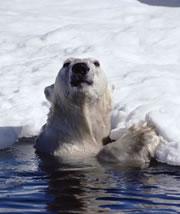 Open water: Polar bears may have a hard time swimming greater distances as the ice melts.© Getty
Open water: Polar bears may have a hard time swimming greater distances as the ice melts.© GettyReports this week claimed that polar bears were being forced by climate change into cannibalism and attempting suicidal swims. Experts say it is too early to be sure, but that these are the kind of impacts expected as melting sea ice leaves the bears with longer distances to travel.
At the sixteenth biennial conference on the biology of sea mammals in San Diego, California, last week, marine biologists from the US Minerals Management Service reported finding four bears drowned off the northern coast of Alaska last autumn. They also spotted an unusually large number of bears swimming in the open sea, some as far as 95 kilometres offshore. Twenty percent of bears seen in the area in September were in the water, while records from previous years show that 4% of sighted bears were swimming.
Tonje Folkestad, climate-change officer at the World Wildlife Fund's Arctic programme in Oslo, Norway, agrees that bears are at risk from melting ice, but says it's too early to conclude that more are drowning because of climate change.
"We can't say at the moment that there is a trend for polar bears to drown," she says. "But we do expect to see more of this kind of event in the future." Spending more time in the open sea increases bears' exposure to the risks of the effect of cold, exhaustion or rough seas. "Common sense tells you that if they have to swim 60 miles instead of 20, drowning is more likely," adds Folkestad.
Going, going, gone
“We expect to see more of this kind of event in the future.”
Tonje Folkestad
WWF
Folkestad says the trend of melting Arctic ice, which is the main habitat for polar bears, presents real problems for the species. The ice sheet is shrinking at a rate of about 10% per decade, with Arctic summer temperatures climbing to around 2 °C higher than they were 50 years ago. About 1.3 million square kilometres, an area equivalent to three times that of California, have been lost over the past four years.
The new report is not hard proof of clear links between melting ice and negative effects on polar bears. But as anecdotal evidence accumulates, conservationists and scientists are becoming concerned. Researchers funded by the WWF in Yakutia, northeastern Russia, have seen an unusually high number of bears in the area this year, as well as recording a record low for sea ice.
Conservation rangers in Yakutia saw two incidents of one bear killing another, with some media reports claiming that starving bears were practicing 'cannibalism'. "These observations are not rare or extraordinary in themselves," says Folkestad, "what was unusual was the lack of sea ice in the area."
Conservation specialists are convinced that action is necessary to find out more about how melting ice is affecting bears, in anticipation of serious problems to come.
Special status
In June 2005, the world conservation union (IUCN) polar bear specialist group decided polar bears should have their conservation status upgraded from 'least concern' to 'vulnerable'. The panel, made up of the world's leading polar bear experts, did so because they expect a 30% decline within the next 35 to 50 years, due to loss of their ice habitat.
Most populations seem steady, but a study to be published next year by the US Geological Survey and Canadian Wildlife Service will show a serious decline in the population of polar bears in Hudson Bay, Canada. The number of bears has fallen by 22% since 1987, dropping to 935 animals last year.
ADVERTISEMENT
"That's a worrying sign," says Folkestad, "this is the most southerly population of bears where there is the least ice anyway, so we might expect this to happen elsewhere as melting progresses." She says more research needs to be done on how polar bears are being affected by shrinking ice.
On Thursday 15 December, three conservation groups launched a bid to use the courts to force the US government to protect polar bears. The Center for Biological Diversity, the Natural Resources Defense Council and Greenpeace are suing the US government for failing to act on a petition sent to the US Fish and Wildlife Service in February. It asked that polar bears be designated as 'threatened' under the Endangered Species Act. If the case is successful, the necessary steps to list polar bears as threatened could take up to two years.
<p/>
WWF
